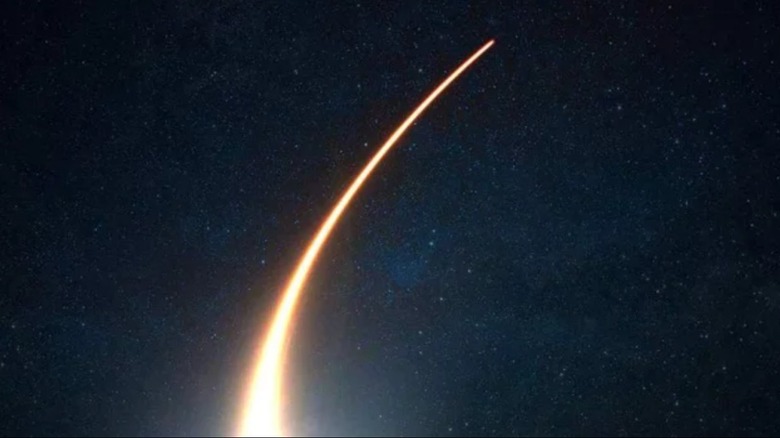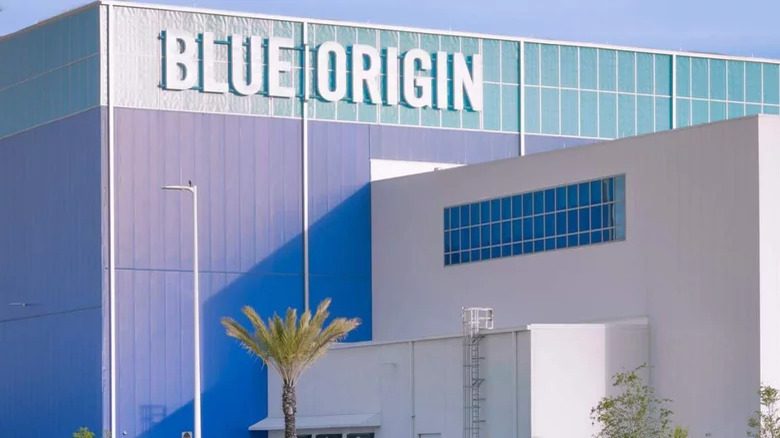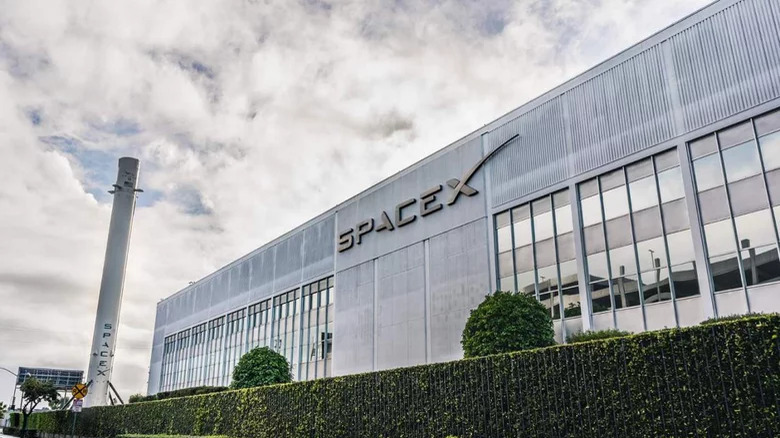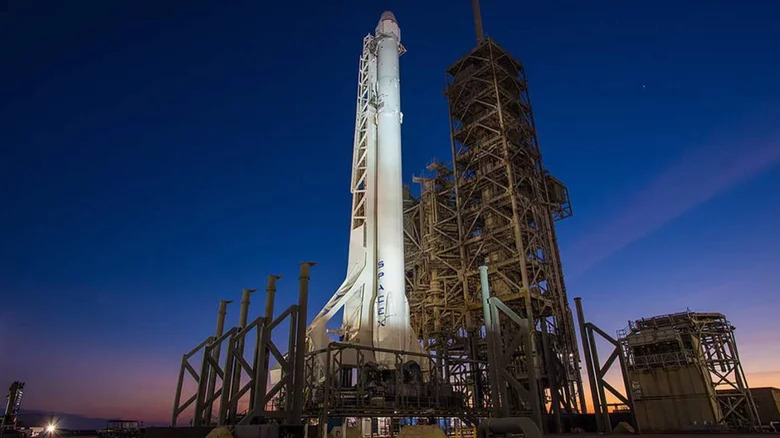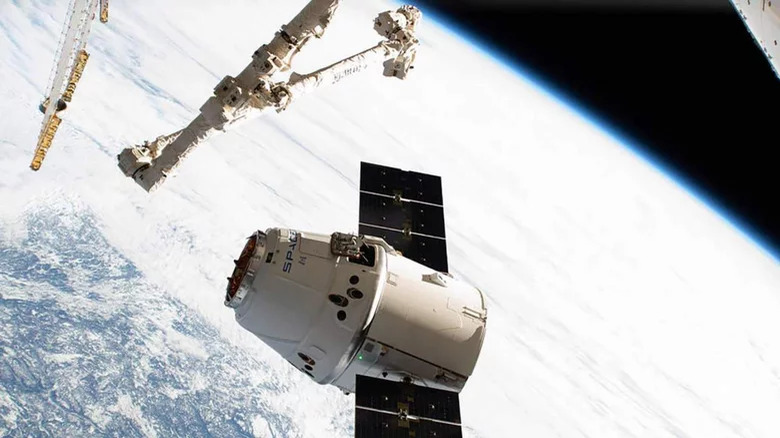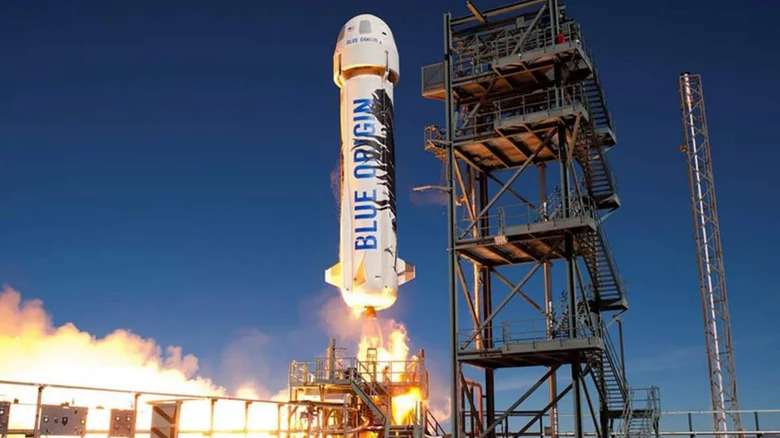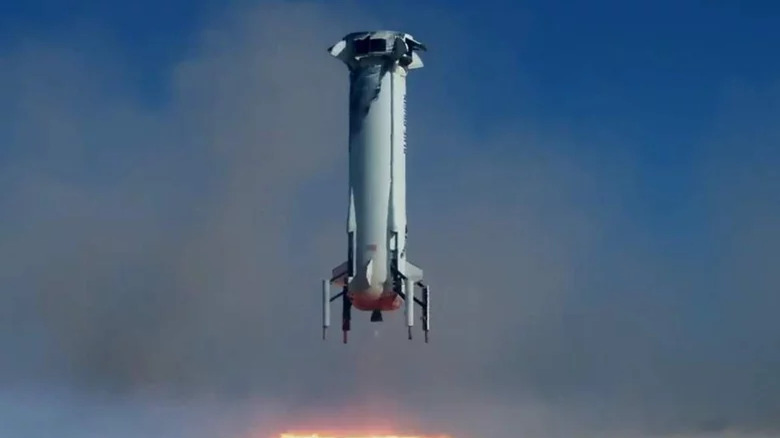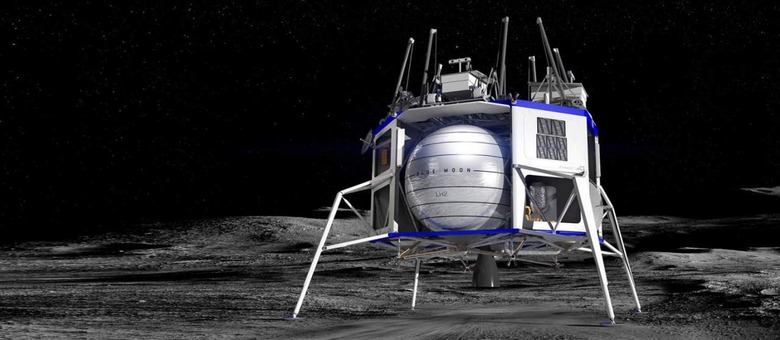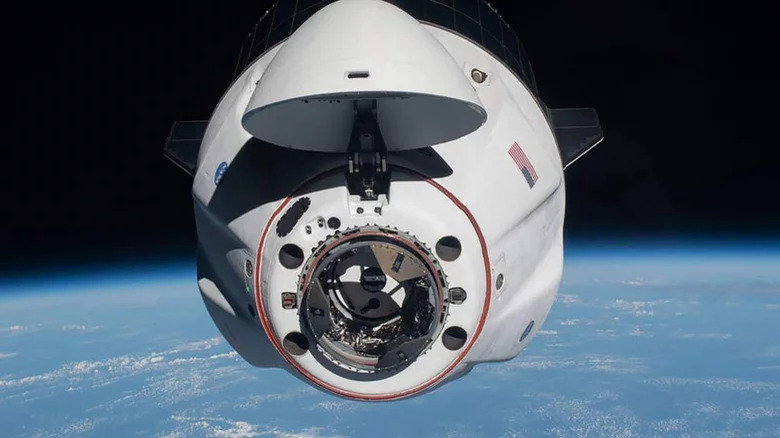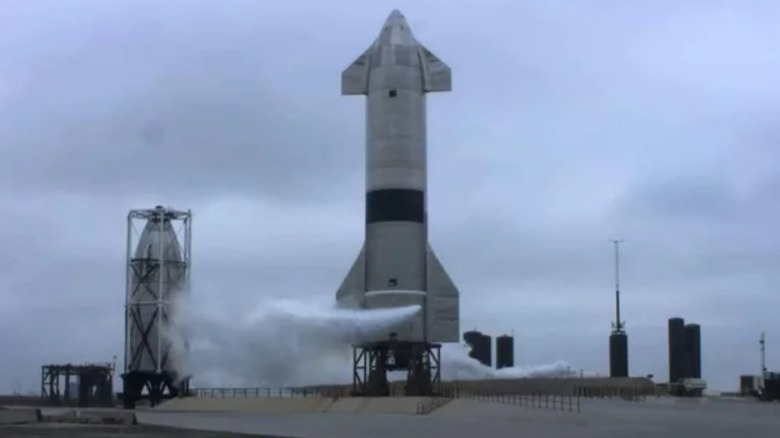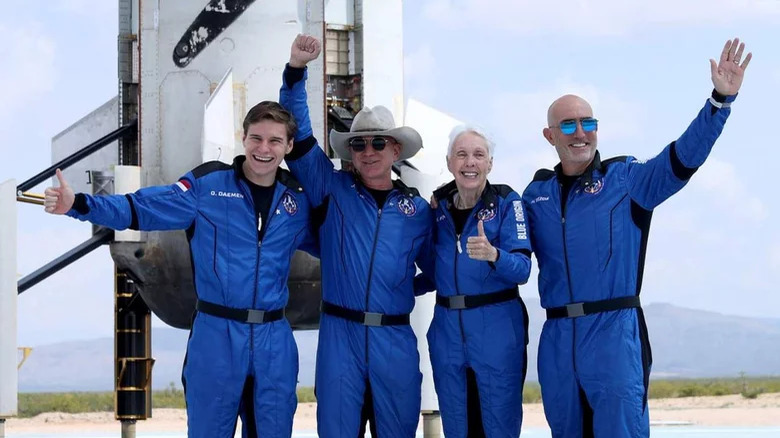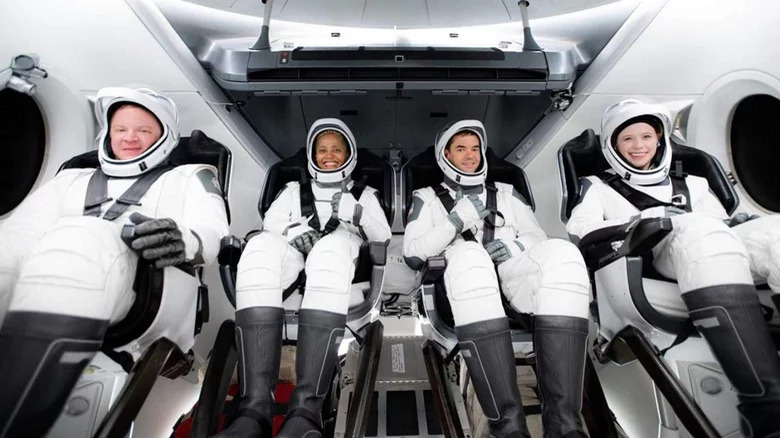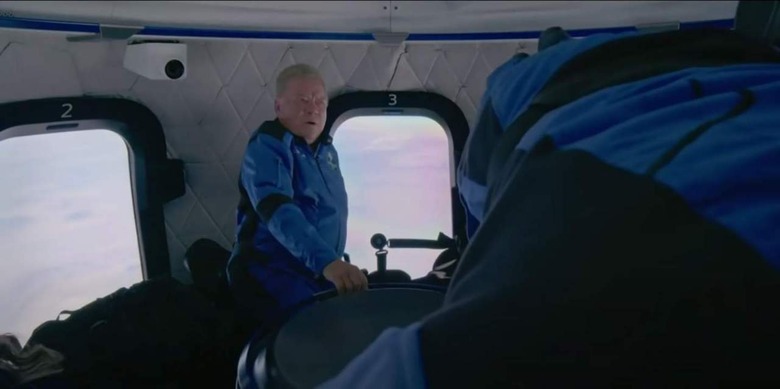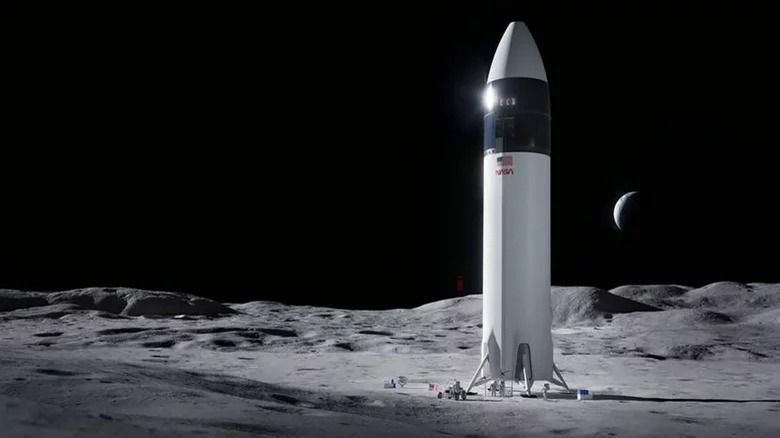SpaceX Vs. Blue Origin: Who Is Winning And Why?
Space exploration was once purely the domain of government agencies. First, the United States and the Soviet Union — later Russia — raced to put a human being on the moon (via History). Later, other countries entered the mix. As World Population Review outlines, more than one dozen countries have space programs today, many of which are capable of launch and a smaller subset are working together on ambitious projects like the International Space Station.
But today the domain of space is no longer only attainable by governments. Commercial entities regularly launch satellites, The Washington Post notes, and a few companies have set their sites on space exploration rivaling that of NASA. In recent years, SpaceX and Blue Origin — each companies owned by wealthy businessmen — have cracked through the highest of earthly ceilings to reach for the stars.
The recent successes of both SpaceX and Blue Origins are only the latest events in an ongoing commercial space race that is aiming for space tourism, a return to the Moon, and missions to Mars and beyond. The question is, who's winning?
The founding of Blue Origin
If we want to search for a starting line for the modern commercial space race, we'd likely find it at the turn of the century with the founding of Blue Origin. Former Amazon CEO and one of the richest humans, Jeff Bezos, created the company in 2000 with the aim of making space travel more affordable and accessible for a larger — albeit still small and incredibly wealthy — portion of humanity.
As arsTechnica explains, single-use launch systems are one of the reasons traveling beyond Earth's atmosphere is so expensive and Blue Origin set out to create reusable rockets in hopes of reducing the overall cost. The first 15 years of the company's existence were shrouded in secrecy while Jeff Bezos and team developed their technologies, but recent years have seen the company emerge from the shadows with a slate of successful launches. Their efforts to this point have been heavily targeted toward space tourism, as evidenced by recent flights which have made headlines. For example, the company sent actor Michael Strahan to space, The Washington Post reported.
Overall, the company got off to a slow start, but that doesn't mean we should necessarily count them out. While recent flights have been brief and have ventured only to the edge of space, the company has its sights set on more distant locales.
The founding of SpaceX
Almost on the heels of Blue Origin, SpaceX was founded by Elon Musk in 2002, according to Brittanica. Musk has made a name for himself as the face of various technology companies including Tesla, PayPal, and The Boring Company, in addition to SpaceX. It's even been rumored that Musk was the inspiration for Robert Downey Jr's portrayal of Tony Stark.
Like Jeff Bezos, Musk created SpaceX with the goal of making space travel more affordable through innovations like reusable rockets (via Investopedia). Unlike Bezos, Musk has made no attempt to hide his loftier goals, namely that of colonizing Mars as quickly as possible. Over the course of the past two decades, SpaceX has made swift strides into space by developing a slate of rockets, a crew delivery craft, and establishing a consistent relationship with NASA on various missions, Slate reported.
By this point, as Slate notes, SpaceX has become a major player in commercial space activity. Their launch capabilities are so consistent that they broke a record in 2021 with a total of 31 launches, many of which were in support of the company's Starlink satellite internet program (via Space).
First launch of the Falcon 9
Only four years after the founding of SpaceX, the company completed its first test flights of the Falcon 1 (via Brittanica). That flight ended in failure when a fuel leak led to a fire, which caused the craft to fail. After two more failed test flights, the Falcon 1 finally made its way into orbit in 2008. This successful flight served as a proof of concept of SpaceX's flight capabilities and Falcon 1 was quickly retired in favor of the company's true workhorse, the Falcon 9.
Both rockets, in addition to the Falcon Heavy, take their names from the Millennium Falcon of "Star Wars" fame, as Space Flight Now notes. The numerical designator in the name refers to the 9 Merlin engines which power the rocket's first stage.
The Falcon 9 saw its first successful launch in June of 2010 from Cape Canaveral in Florida. Development of the rocket was funded in part by a contract from NASA with the intent of flying missions to the International Space Station, as The Washington Post noted. Since that first successful flight, SpaceX has flown more than 80 times, according to the Federal Aviation Administration, making SpaceX a substantial player in contemporary spaceflight.
SpaceX becomes the first private company to fly to the ISS
In May of 2012, a little more than two years after the first launch of the Falcon 9, it lifted off from Space Launch Complex-40 in Cape Canaveral carrying its Dragon capsule to the International Space Station (via Space).
The mission marked a historic first in commercial spaceflight when the Dragon spacecraft became the first private craft to ever connect with the ISS. While it was capable of carrying more than 7,000 pounds of cargo, this first mission ferried only 1,200 pounds, consisting mostly of food and clothes for orbiting astronauts, as well as experiments designed by students.
After reaching orbit, Space notes, the Dragon took a meandering three-day journey to the station, intended to ensure that all systems were working correctly and safely, and that the crew on board the station could communicate with it, before docking. According to NASA, SpaceX has now made 24 cargo deliveries to the ISS with a 25th planned for May of 2022, almost ten years to the day after this historic first.
Blue Origin's first test flight of the New Shepard
On April 29, 2015, after 15 years of near-total secrecy, Blue Origin launched its New Shepard rocket from its launch site in Texas, Space notes. The rocket, named after the first American to go to space, Alan Shepard, flew to a height of 307,000 feet and the flight went off nearly flawlessly, with one major hitch.
The rocket's propulsion module was lost due to a loss of pressure in the hydraulic system. This, in and of itself, is not usually seen as a failure. To that point, propulsion systems had not typically been recovered, but Blue Origin set a goal of reusability in their design and fully intended to recover the propulsion module.
The loss of the module notwithstanding, the flight was deemed a successful first outing for the company and began what would become the most public era of Blue Origin's operations. After the test flight, the company predicted they were a few years away from completing suborbital flights with a crew. That prediction would come true five years later (via Space News).
The birth of reusable rockets
It didn't take Blue Origin long to recover from the loss of their propulsion module during the first test flight. In fact, before 2015 was out, they successfully ran another test in which the rocket launched and landed intact back on the ground (via EO Portal). This historic milestone was achieved on November 23, 2015.
To this point, SpaceX and Blue Origin had been in a race to be the first to recover a rocket for reuse. While SpaceX gets all the press for their reusable Dragon 9 rockets, it was actually Blue Origin who crossed that threshold first, as The Atlantic noted. Perhaps motivated by the attention Blue Origin was getting, SpaceX wasted no time in accomplishing the same thing. Less than a month later, on December 21, 2015, the company successfully recovered the first stage of their Falcon 9 rocket.
These two flights checked off a threshold for both companies in realizing the goal of more affordable and more reliable space flight by allowing boosters to be used more than once. It's estimated that the reuse of Falcon 9 rockets saves about 21% of the total cost of launch.
Blue Origin announces their Blue Moon lunar lander
While Blue Origin has so far kept their ambitions close to Earth, focusing primarily on suborbital flights, they're looking to loftier ground. In 2019, Jeff Bezos revealed a lunar lander called Blue Moon, which the company had been developing for three years at that point. The craft was displayed via full-scale mockup on stage with Bezos and that version of Blue Moon could be used for uncrewed missions, delivering cargo like lunar rovers or experimental payloads to the lunar surface. An enhanced version that is bigger and has a pressurized compartment could be used for ferrying astronauts during NASA's upcoming Artemis missions.
Blue Origin, along with their partners, were collectively awarded a $579 million contract in 2020 intended to help them build a human landing system for lunar missions. That contract was intended for preliminary study and not the actual construction of a craft.
But the role of landing the next batch of humans on the Moon won't be going to Blue Origin. NASA has selected SpaceX to develop the human landing system for the Artemis missions, the agency announced.
SpaceX's Crew Dragon spacecraft
After the space shuttle program was shuttered in 2011 following the completion of the International Space Station, the United States lost the ability to launch astronauts from U.S. soil (via Space). At that point, all crew launches lifted off from Russia on the Soyuz spacecraft, Forbes reported. One of NASA's primary goals in the intervening years was to return launch capabilities to the United States and that goal was accomplished in 2020 with the successful flight of Demo-2. The highly-publicized flight took place after Demo-1, which was uncrewed but successfully docked with the International Space Station.
Demo-2 launched on May 30, 2020, from the Kennedy Space Center carrying astronauts Robert Behnken and Douglas Hurley on a month's-long mission the International Space Station (via NASA). The flight served as SpaceX's final test flight of the Crew Dragon capsule and successfully returned launch capability to the United States.
Since then, SpaceX has launched additional operational crewed missions with larger crews to the ISS, all of which have been completed successfully. The success of Crew Dragon proves that SpaceX can not only launch and reuse rockets, but they can also use them to safely carry astronauts.
Successful test flight and landing of Starship
SpaceX's Starship spacecraft is a next-generation spaceship intended to carry humans to the Moon, Mars, and elsewhere in the solar system on the back of their Super Heavy rockets. Much like the reusable Falcon 9 rockets, Starship is designed to launch and have a soft landing on the ground. It does this in a unique way — by rotating so that it's falling while horizontal, before reorienting for a vertical landing. Tests of Starship have been riddled with failure as SpaceX attempted to fine-tune the landing sequence and several ships were destroyed in the process, Live Science reported.
SpaceX, however, is not a company with a habit of being deterred. In spaceflight, failures are often the thing needed for the next success. Each test flight provided an opportunity for SpaceX to modify the prototype and make it work. In May of 2021, they did just that, Space noted. SN15 lifted off from the launchpad, rose more than six miles, and touched down on the ground. This time, it didn't blow up.
Blue Origin's first crewed flight
p>In July of 2021, Blue Origin made good on their promise of delivering humans on suborbital flights with the success of their first crewed launch (via Space). Their New Shepard spacecraft took off from the company's launch site in Texas shortly after 9:00 in the morning. The crew of four included Jeff Bezos himself, as well as Wally Funk, who set the record for the oldest person to venture into space at the age of 82. Funk was one of 13 women who trained alongside Mercury astronauts during NASA's earliest programs.
Unfortunately, neither Funk nor any of the other women who trained were given the opportunity to fly. The New Shepard flight made a small step toward rectifying that. It also cemented Blue Origin in the history of private spaceflight. The flight itself lasted only about ten minutes but did surpass the Kármán line, the point at which a craft can no longer rely on lift, and one of the markers regularly recognized as the boundary of space.
Inspiration4, the world's first all private orbital crew
SpaceX's Crew Dragon capsule has proven successful at delivering trained astronauts to the International Space Station but was also designed for commercial flights which are open to civilians. The first of those flights took place on September 15, 2021, when the Inspiration4 crew lifted off from the Kennedy Space Center.
The flight was chartered by billionaire Jared Isaacman as part of a fundraising effort for St. Jude Children's Research Hospital, CBS reported. Isaacman himself flew as part of the crew of Inspiration4, alongside Hayley Arceneaux, Chris Sembroski, and Sian Proctor. Notably, Arceneaux was treated for bone cancer at St. Jude when she was a child. She later obtained a Physician Assistant degree and now works at the hospital.
Inspiration4 remained in orbit for three days and made history as the first-ever orbital mission comprised entirely of civilians. During the three-day mission, the crew orbited the Earth 364 miles above the surface before returning safely home (via Space).
William Shatner goes to space
William Shatner became a household name as the captain of the U.S.S. Enterprise in the original "Star Trek" series and feature films. The franchise has inspired generations of scientists and astronauts, so it seems only fitting that he should have an opportunity to see the place he spent so much time popularizing. On October 12, 2021, Shatner joined the crew of Blue Origin's second crewed spaceflight aboard New Shepard. At the age of 90, the flight made him the oldest person to fly into space, beating out Wally Funk's previous record set on New Shepard's previous flight (via NASA). Shatner was joined in space by Audrey Powers, Chris Boshuizen, and Glen de Vries.
Like the previous flight, this one lasted only about ten minutes, but USAToday reported that Shatner said it was enough to reframe his view of the world. It may have been Blue Origin's second crewed flight, but Shatner's star power brought a lot of attention to the company. It also proved Blue Origin wasn't a one-hit wonder with their private suborbital flights.
Do we have a verdict?
Despite Blue Origin getting a two-year head start, SpaceX was able to quickly ramp up and make a name for itself in commercial spaceflight. For a while it seemed as though the two companies were running different races, with Blue Origin focused largely on space tourism, while SpaceX was in the exploration game from the jump.
Both companies have proven themselves to be formidable at achieving their goals, getting people off the ground, and returning them safely to Earth. In one very important respect, that is the only crucial measure for the success of a space program.
Still, SpaceX has dozens more missions than Blue Origin, including consistent missions to the ISS, delivering both crew and cargo. At least right now, SpaceX is leagues ahead of Blue Origin and the announcement of their involvement with the upcoming Artemis missions appears to cement that legacy. If the previous space race taught us anything, it's that getting boots on the ground is what people really care about.
In the end, however, the competition between the two companies and their rivals has made space travel more affordable and more frequent. All things considered, the real winners are all of us.
